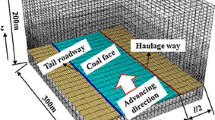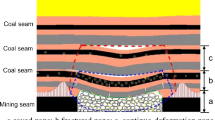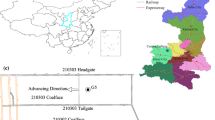Abstract
At present, the prediction of the height of fractured water-conducting zone has become increasingly important for the safety of underground mining, since the mining depth increase continuously. According to mining conditions and petrophysical parameters of overburden strata, a suitable numerical model is established by FLAC3D to carry out numerical analysis on the failure of the plastic zone, the stress distribution and the vertical displacement in the overburden strata with the advancement of 1311 working face. Combining the stress characteristics of the typical “three-zones” theoretical, numerical resolutions of the height of fractured water-conducting zone is obtained by comprehensively analyzing simulation results. Synthesize the numerical solutions and the in situ investigation results, the height of caved zone and fractured water-conducting zone are determined as 53 m and 125 m, respectively. It is pointed out that numerical simulation has the advantages of easy implementation and good accuracy, and can be combined with other methods to accurately predict the fractured water-conducting zone height. The outcome of this work has vital guiding significance for the prevention of roof water disasters and ensuring mine safety in 1311 working face mining.











Similar content being viewed by others
References
Cao A, Zhu L, Li F, Dou L, Zhao Y, Zhang Z (2014) Characteristics of T-type overburden structure and tremor activity in isolated face mining under thick-hard strata. J China Coal Soc 39(2):328–335
Chen R, Bai H, Feng M (2006) Determination of the height of water flowing fractured zone in overburden strata above fully-mechanized top-coal caving face. J Min Saf Eng 23(2):220–223
Cheng G, Ma T, Tang C, Liu H, Wang S (2017) A zoning model for coal mining—induced strata movement based on microseismic monitoring. Int J Rock Mech Min Sci 94:123–138
Fan G, Zhang D, Ma L (2011) Overburden movement and fracture distribution induced by longwall mining of the shallow coal seam in the Shendong coalfield. J China Univ Min Technol 40(2):196–201
Gui H, Zhou Q, Liao D, Kang Q, Fan Z, Zou H (1997) Prediction of maximum height of the fractured zone by stressing method for sub-level caving mining. J China Coal Soc 22(4):375–379
Guo H, Yuan L, Shen B, Qu Q, Xue J (2012) Mining-induced strata stress changes, fractures and gas flow dynamics in multi-seam longwall mining. Int J Rock Mech Min Sci 54:129–139
Han J, Zhang H, Gao Z, Rong H, Zhao X, Yang F, Wang J (2016) Failure height of weak overburden by layered fully-mechanized mining in extremely thick coal seam. J Min Saf Eng 33(2):226–230 and 237
Hu X, Li W, Cao D, Liu M (2012) Index of multiple factors and expected height of fully mechanized water flowing fractured zone. J China Coal Soc 37(4):613–620
Hu T, Hou G, Bu S, Zhu Z, Wang Y, Hu Z, Li Z (2020) A novel approach for predicting the height of water-conducting fracture zone under the high overburden caving strength based on optimized processes. Processes 8(8):950
Huang Q (2007) Experimental research of overburden movement and subsurface water seeping in shallow seam mining. J Univ Sci Technol Beijing 14(6):483–489
Huang Z, Tong H, Zhang Y, Li S, Ni W, Song J, Xing Y (2006) Dividing guideline and emulating determination of three zones of the depressing zones overlying a goaf. J Univ Sci Technol Beijing 28(7):609–612
Huang WP, Li C, Zhang LW, Yuan Q, Zheng YS, Liu Y (2018) In situ identification of water-permeable fractured zone in overlying composite strata. Int J Rock Mech Min Sci 105:85–97
Jiang J, Zhang P, Nie L, Li H, Xu L, Wang W (2014) Fracturing and dynamic response of high and thick stratas of hard rocks. Chin J Rock Mechan Eng 33(7):1366–1374
Li P, Wang X, Cao W, Zhang D, Qin D, Wang H (2018) Influence of spatial relationships between key strata on the height of mining-induced fracture zone: a case study of thick coal seam mining. Energies 11(1):102
Liu C (2011) Similar simulation study on the movement behavior of overlying strata in shallow seam mining in Majiliang Coal Mine. J China Coal Soc 36(1):7–11
Liu H, Liu J, Tang C (2001) Numerical simulation of failure process of overburden rock strata caused by mining excavation. Chin J Geotech Eng 23(2):201–204
Lv W (2014) Measure and simulation for development height of water conducted crack zone in overburden roof. J Xi’an Univ Sci Technol 34(3):309–313
Miao X, Cui X, Wang J, Xu J (2011) The height of fractured water-conducting zone in undermined rock strata. Eng Geol 120(1–4):32–39
Palchik V (2003) Formation of fractured zones in overburden due to longwall mining. Environ Geol 44(1):28–38
Qu Q, Xu J, Wu R, Qin W, Hu G (2015) Three-zone characterisation of coupled strata and gas behaviour in multi-seam mining. Int J Rock Mech Min Sci 78:91–98
Ren W, Guo C, Peng Z, Wang Y (2010) Model experimental research on deformation and subsidence characteristics of ground and wall rock due to mining under thick overlying terrane. Int J Rock Mech Min Sci 47(4):614–624
Shi L, Xin H, Zhai P, Li S, Liu T, Yan Y, Wei W (2012) Calculating the height of water flowing fracture zone in deep mining. J China Univ Min Technol 41(1):37–41
Wang F, Zhang C, Zhang X, Song Q (2015) Overlying strata movement rules and safety mining technology for the shallow depth seam proximity beneath a room mining goaf. Int J Min Sci Technol 25(1):139–143
Wang J, Wang Z, Li Y (2020) Longwall top coal caving mechanisms in the fractured thick coal seam. Int J Geomech 20(8):06020017
Xu J, Zhu W, Wang X (2012) New method to predict the height of fractured water-conducting zone by location of key strata. J China Coal Soc 37(5):762–769
Ye Q, Wang G, Jia Z, Zheng C, Wang W (2018) Similarity simulation of mining-crack-evolution characteristics of overburden strata in deep coal mining with large dip. J Petrol Sci Eng 165:477–487
Yu B, Zhao J, Kuang T, Meng X (2015) In situ investigations into overburden failures of a super-thick coal seam for longwall top coal caving. Int J Rock Mech Min Sci 78:155–162
Zhang Y, Li F (2011) Monitoring analysis of fissure development evolution and height of overburden failure of high tension fully-mechanized caving mining. Chin J Rock Mechan Eng 30(Supp. 1):2994–3001
Zhang J, Shen B (2004) Coal mining under aquifers in China: a case study. Int J Rock Mech Min Sci 41(4):629–639
Zhang J, Wang J (2014) Similar simulation and practical research on the mining overburden roof strata “three-zones” height. J Min Saf Eng 31(2):249–254
Zhu H, Fang S, Huo Y, Guo J, Wu Y, Hu L (2020) Study of the dynamic development law of overburden breakage on mining faces. Sci Rep 10(1):1–15
Author information
Authors and Affiliations
Corresponding author
Ethics declarations
Conflict of interest
The authors declared that they have no conflict of interest to this work.
Additional information
Publisher's Note
Springer Nature remains neutral with regard to jurisdictional claims in published maps and institutional affiliations.
Rights and permissions
About this article
Cite this article
Ren, S., Cui, F., Zhao, S. et al. Investigation of the Height of Fractured Water-Conducting Zone: A Case Study. Geotech Geol Eng 39, 3019–3031 (2021). https://doi.org/10.1007/s10706-020-01675-x
Received:
Accepted:
Published:
Issue Date:
DOI: https://doi.org/10.1007/s10706-020-01675-x




